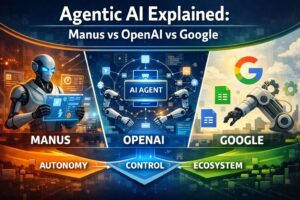执行摘要 Agentic AI 已不再停留在研究阶段。对中国企业而言,它正逐步进入实际应用,用于提升运营效率、整合现有系统、推动数字化与智能化升级。 但需要注意的是,不同的 Agentic AI 采用了完全不同的设计理念。如果忽视这一点,可能会在安全、治理和长期运维方面带来风险。 本文将对以下三种主流路径进行对比分析: Manus(高度自主的 Agentic AI) OpenAI Agentic AI(由企业设计和控制的 Agentic AI) Google Agentic AI(深度集成于 Google 生态的 Agentic AI) 为中国企业在真实业务环境中的决策提供参考。
Read Moreエグゼクティブサマリー Agentic AIは、もはや研究段階の技術ではありません。日本企業においても、既存システムの活用、業務自動化、生産性向上を目的に、実運用への導入が始まっています。 しかし、すべてのAgentic AIが同じ思想で設計されているわけではありません。選択を誤ると、ガバナンスや運用面で大きなリスクを抱える可能性があります。 本記事では、以下3つのアプローチを比較します。 Manus(高い自律性を持つAgentic AI) OpenAI Agentic AI(企業が設計・制御するAgentic AI) Google Agentic AI(Googleエコシステムに統合されたAgentic AI) 日本企業の実務に適した判断材料としてご活用ください。
Read Moreสรุปสำหรับผู้บริหาร Agentic AI ไม่ใช่แนวคิดเชิงวิจัยอีกต่อไป แต่กำลังถูกนำมาใช้จริงในองค์กร เพื่อช่วยลดงานซ้ำซ้อน เชื่อมต่อระบบเดิม และเพิ่มประสิทธิภาพการดำเนินงาน อย่างไรก็ตาม Agentic AI แต่ละแนวทางไม่ได้ถูกออกแบบมาเหมือนกัน และการเลือกผิดอาจสร้างความเสี่ยงด้านการควบคุมและความน่าเชื่อถือของระบบ บทความนี้อธิบายความแตกต่างระหว่าง: Manus (เอเจนต์ AI ที่ทำงานอัตโนมัติสูง) OpenAI Agentic AI (เอเจนต์ที่องค์กรออกแบบและควบคุมได้) Google Agentic AI (เอเจนต์ที่ฝังอยู่ในระบบของ Google) เพื่อช่วยให้องค์กรไทยเลือกแนวทางที่เหมาะสมกับการใช้งานจริง ไม่ใช่แค่ตามกระแส
Read MoreExecutive summary Agentic AI is no longer a research concept. It is already reshaping how enterprises automate work, integrate legacy systems, and scale operations. But not all agentic AI systems are built the same. In this article, we explain the real difference between: Manus (fully autonomous AI agents) OpenAI’s agentic AI frameworks Google’s agentic AI […]
Read More1. 中国医院语境下的“纵向整合”是什么 在中国医院中,纵向整合(Vertical Integration)指的是将以下环节打通为一个连续、可智能决策的整体系统: 患者 → 诊疗 → 检验 / 医学影像 → 医院运营 → 费用结算 / 医保 → 管理决策 目前大多数中国医院已经拥有: HIS / EMR LIS(检验系统) PACS(影像系统) 收费 / 医保结算系统 但现实问题是: 👉 系统之间“能传数据”,但“不理解彼此” AI 正是解决这一断层的关键技术。
Read More1. Vertical Integration ในบริบทของโรงพยาบาลไทยคืออะไร Vertical Integration ของโรงพยาบาล หมายถึงการเชื่อมโยงระบบตั้งแต่ต้นน้ำถึงปลายน้ำให้ทำงานเป็นหนึ่งเดียว ได้แก่ ผู้ป่วย → การรักษา → ห้องแล็บ / ภาพทางการแพทย์ → การบริหารโรงพยาบาล → การเงิน / การเรียกเก็บเงิน → การตัดสินใจเชิงบริหาร โรงพยาบาลไทยส่วนใหญ่มีระบบเหล่านี้อยู่แล้ว เช่น HIS / EMR LIS (Laboratory) PACS (Medical Imaging) ระบบการเงิน / Billing แต่ปัญหาคือ 👉 ระบบเชื่อมกันในระดับข้อมูล แต่ไม่เชื่อมกันในระดับความเข้าใจและการตัดสินใจ AI เข้ามาเติมช่องว่างนี้
Read More1. 日本の病院における「垂直統合」とは何か 病院における垂直統合とは、 患者接点 → 診療 → 検査・画像 → 病院運営 → 会計・請求 → 経営判断 までを、一貫した文脈(コンテキスト)と意思決定フローで結びつけることを意味します。 日本の多くの病院では、 電子カルテ(HIS / EMR) 検体検査システム(LIS) 画像管理(PACS) 医事会計・DPC は既に存在しますが、 👉 「接続されているが、理解されていない」 状態に留まっています。
Read More1. What Vertical Integration Means in a Hospital Context Vertical integration in hospitals means connecting patient-facing, clinical, operational, and financial systems into one continuous, intelligent flow. Instead of isolated software silos, the hospital operates as a single system where data, decisions, and actions move seamlessly end to end. Patient → Clinical Care → Diagnostics → […]
Read More过去几年,工业AI的讨论大多集中在AI模型本身: 模型精度、训练数据规模、算法先进性。 这些当然重要,但在迈向 2026 年的过程中,中国制造业正在发生明显转变。 真正决定成败的,不再是“用了什么模型”, 而是 AI 能否作为工业系统的一部分,长期、稳定、安全地运行。 正是在这个层面上,AI 加速器与软件框架开始成为关键。
Read MoreこれまでIndustrial AIの議論は、AIモデルに焦点が当たることがほとんどでした。 精度、データ量、アルゴリズム──それらは確かに重要です。 しかし2026年に向けて、製造業の現場では視点が大きく変わりつつあります。 本当に差を生むのは「どのモデルを使うか」ではなく、 AIを実システムとして、長期間・安全・安定的に動かせるかどうかです。 この変化の中心にあるのが、AIアクセラレータとソフトウェアフレームワークです。
Read Moreตลอดหลายปีที่ผ่านมา การพูดถึง Industrial AI มักโฟกัสไปที่ โมเดล ไม่ว่าจะเป็นความแม่นยำ ชุดข้อมูล หรืออัลกอริทึม แต่ในปี 2026 มุมมองนี้กำลังเปลี่ยนไป สิ่งที่สร้างความแตกต่างจริงในสภาพแวดล้อมอุตสาหกรรม ไม่ใช่ ใช้โมเดลอะไร แต่คือ การนำ AI ไปทำงานในระบบจริงได้อย่างเสถียร มีประสิทธิภาพ และปลอดภัย และนี่คือจุดที่ AI Accelerators และ Software Frameworks เข้ามาเปลี่ยนเกมของตลาดอย่างเงียบ ๆ
Read MoreFor years, industrial AI discussions focused on models: accuracy, datasets, and algorithms. In 2026, that focus is shifting. The real differentiator in industrial environments is no longer which model you use, but how AI is executed reliably, efficiently, and safely inside real systems. This is where AI accelerators and software frameworks quietly redefine the market.
Read More为什么中国企业更需要“可靠的自动化”,而不仅仅是 AI 在中国的大中型企业中,电商系统、ERP、财务系统、仓储系统以及各类内部平台,往往是在不同阶段、由不同团队逐步建设而成。这种长期演进带来了常见的问题: 系统之间存在 API,但能力受限或不稳定 大量业务仍依赖 CSV、批处理或人工操作 一次业务流程调整,往往牵一发动全身,风险高、成本大 因此,管理层与 IT 团队经常会说: “我们希望自动化,但不能出错。” “AI 很有价值,但不能直接修改核心业务数据。”
Read Moreทำไมองค์กรไทยต้องการ “ระบบอัตโนมัติที่ไว้ใจได้” มากกว่าคำว่า AI ในองค์กรไทยจำนวนมาก ระบบ e‑commerce, ERP, ระบบบัญชี, ระบบคลังสินค้า และระบบภายใน ถูกพัฒนาแยกกันมายาวนาน ทำให้เกิดปัญหาที่พบได้บ่อย เช่น มี API แต่ใช้งานได้จำกัด หรือไม่เสถียร ยังพึ่งพาไฟล์ CSV, งาน batch, หรือการทำงานด้วยคน การเปลี่ยนกระบวนการธุรกิจหนึ่งครั้ง มีความเสี่ยงสูงและต้นทุนแพง ผู้บริหารและทีมไอทีมักพูดเหมือนกันว่า: “อยากทำระบบอัตโนมัติ แต่พลาดไม่ได้” “อยากใช้ AI แต่ไม่สามารถให้ AI ไปแก้ข้อมูลธุรกิจตรง ๆ ได้” เราจึงออกแบบระบบโดยแยก AI, Workflow และการทำงานจริงของระบบธุรกิจออกจากกันอย่างชัดเจน เพื่อให้ใช้งานได้จริงในบริบทองค์กรไทย
Read MoreWhy Enterprises Worldwide Need Reliable Automation Now Across global enterprises, e-commerce platforms, ERP systems, internal tools, and legacy applications have evolved independently over many years. The result is a complex operational landscape where: APIs exist but are limited, unstable, or inconsistent File-based integration (CSV, batch jobs, SFTP) is still mission-critical Business changes require costly, risky […]
Read Moreなぜ今、日本企業に「信頼できる自動化」が必要なのか 多くの日本企業では、ECシステム、ERP、基幹業務、社内ポータル、さらにはレガシーシステムが長年にわたり複雑に連携してきました。 APIが存在しない、または制限が多い バッチ処理・CSV・人手オペレーションに依存 業務変更=システム改修のコストが高い その結果、 「自動化したいが、失敗が怖い」 「AIを使いたいが、業務に責任を持たせられない」
Read More当一个系统被称为“智能”,但其行为却不可预测时,带来的成本不仅是技术问题,而是会扩散到整个组织。 近年来,AI 与自动化系统在中国被广泛应用于 制造业、客服中心、物流、电商平台、企业内部系统以及公共领域。许多系统在立项和展示阶段看起来“先进”“智能”,但一旦进入真正的生产环境(7×24 小时运行),最关键的问题便暴露出来。 那不是“智能程度”,而是 可靠性(Reliability)。 本文将从 系统架构与工程实践 的角度,解析为什么不可靠的智能系统反而比简单系统成本更高,以及中国企业应如何设计真正可长期运行的 AI 系统。
Read Moreシステムが「スマート」だと主張しても、挙動が予測できなければ、そのコストは技術的問題にとどまらず、組織全体に波及します。 近年、日本企業でも AI や自動化システムが 製造業、コールセンター、物流、社内システム、公共分野 に広く導入されています。多くのシステムが「スマート」「次世代」として導入されますが、実運用(production)に入った途端、最も重要な要素が欠けていることが明らかになります。 それは 知能(Smartness)ではなく、信頼性(Reliability) です。 本記事では、信頼できないスマートシステムがなぜ単純なシステムよりも高いコストを生み、日本企業が長期運用に耐えるシステムをどう設計すべきかを解説します。
Read Moreเมื่อระบบอ้างว่า ฉลาด แต่ทำงานแบบคาดเดาไม่ได้ ต้นทุนที่เกิดขึ้นไม่ใช่แค่เรื่องเทคนิค — แต่กระทบทั้งองค์กร ในช่วงไม่กี่ปีที่ผ่านมา AI และระบบอัตโนมัติถูกนำมาใช้มากขึ้นในองค์กรไทย ไม่ว่าจะเป็น โรงงานอุตสาหกรรม, Call Center, โลจิสติกส์, ระบบภายในองค์กร และหน่วยงานรัฐ หลายระบบถูกทำตลาดว่าเป็นระบบ “Smart” แต่เมื่อใช้งานจริงในสภาพแวดล้อม production ระบบเหล่านี้กลับล้มเหลวในสิ่งที่สำคัญที่สุด ไม่ใช่ความฉลาด แต่คือ: ความเสถียรและความน่าเชื่อถือ (Reliability)
Read MoreWhen a system claims to be smart but behaves unpredictably, the cost is not just technical—it’s organizational. As AI and automation are embedded deeper into enterprises—factories, customer service, logistics, and internal tools—many systems are marketed as “smart”. Yet in real operations, these systems often fail at something more fundamental than intelligence: Reliability.
Read More




